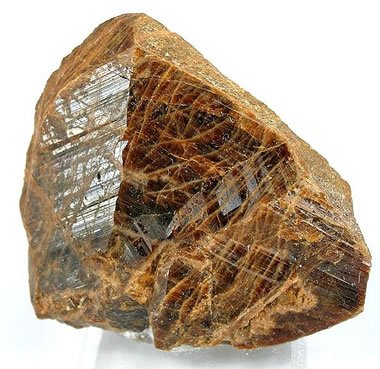Australia - Brazil - Canada - India - Kenya - Madagascar - Mozambique - Senegal - Sierra Leone - South Africa - Sri Lanka - Vietnam
Heavy
mineral sands are an important source of zirconium, titanium, and rare-earth elements. They are placer
deposits formed
usually in beach
environments
by concentration due to the specific
gravity of
the mineral grains. It is also
likely that some concentrations of heavy minerals exist within
streambeds,
but most are of a low grade and are relatively small.
Zirconium
Zirconium
Zirconium
has a concentration of about 130 mg/kg within the Earth's
crust. It
is not found in nature as a native
metal,
reflecting its intrinsic instability with respect to water. The
principal commercial source of zirconium is zircon
(ZrSiO4),
a silicate
mineral.
Zircon (ZrSiO4)
Specific gravity 4.6 - 4.7
Hardness (Mohs hardness scale): 7.5
A lustrous crystal of zircon perched on a tan matrix of calcite from the Gilgit District of Pakistan
World
production trend of zirconium mineral concentrates
Zircon
is mainly consumed as an opacifier
and used in the decorative ceramics industry.
It
is also the principal precursor, not only to metallic zirconium,
although this application is small, but also to all compounds of
zirconium including zirconium
dioxide (ZrO2),
one of the most refractory
materials
known. Other applications include use in refractories and foundry
casting and a growing array of specialty applications as zirconia and
zirconium chemicals, including in nuclear fuel rods, catalytic fuel
converters and in water and air purification systems.
Titanium occurs within a number of mineral deposits, principally as the minerals rutile (TiO2) and ilmenite (FeTiO3), which are widely distributed in the Earth's crust.
Ilmenite
is the primary ore of titanium, a metal needed to make a variety of
high-performance alloys. Most of the ilmenite mined
worldwide is used to manufacture titanium dioxide, TiO2,
an important pigment, whiting, and polishing abrasive. Leucoxene
is a fine, granular alteration product of titanium minerals.
Leucoxene is formed through extensive weathering of ilmenite which
removes iron and increases the titanium content of the mineral
grains. Although it is not a recognized mineral species, the name
leucoxene has been applied to products with a Ti02 titanium
content ranging from 70% to 93%.
Titanium
minerals or titaniferous (TiO2-containing)
feedstocks are principally driven by demand for titanium dioxide
(TiO2)
pigment which is used in applications such as paint, plastics, paper
and inks amongst others. In 2015 the TiO2
pigment market accounted for 83% of titanium mineral demand, while
other end-uses include titanium metal, abrasive, welding rods and
metallurgical fluxes.
There
has been a changing landscape for titanium minerals supply over the
last five years, with a significant rise in production of ilmenite in
China to feed its domestic sulphate route TiO2pigment
manufacture. Elsewhere new sources of supply have some on stream
which have shifted traditional trade patterns.
The
five largest titanium minerals suppliers control nearly half of
global feedstock production and include Cristal, Iluka,
Rio Tinto, TiZir, and Tronox. Since a shortfall
in supply in 2011 and subsequent price spike, producers have since
faced mounting inventories. From 2013, major producers including Rio
Tinto and Iluka, and others have curtailed production, but the
overall supply deficit has been outweighed by a substantial supply
surplus of ilmenite which has dampened prices.
Looking
out to 2025, there are expansion plans from existing producers as
well as new projects are in the pipeline, although some will face
headwinds in the current economic climate. Chinese producers are
actively investigating overseas resources to supplement supply and it
is likely that exports to China will rise again in the medium term.
There
have also been a significant number of mergers and acquisitions in
the TiO2 pigment industry, as well as capacity expansions
in China, and latterly rationalisation in the form of plant closures,
which are reshaping the industry. The paint industry remains the most
important market for TiO2 pigment, accounting for 55% of
consumption in 2015. Meanwhile, the paper industry remains important
but consumption has shifted into specific sectors such as coated
folding boxboard and décor paper for decorative laminates.
The
titanium minerals industry is evolving to supply TiO2
pigment production, will which will shift further towards using more
chloride route production over the next ten years. The underlying
growth rates for TiO2 pigment and titanium metal will
ensure continued demand for titanium minerals.
Monazite(Ce,
La, Nd, ThPO4)
Specific gravity 4.6 – 5.7 (4.98 – 5.43 for monazite-Ce)
Specific gravity 4.6 – 5.7 (4.98 – 5.43 for monazite-Ce)
Hardness 5.0 - 5.5
Monazite is
an important ore
for
thorium,
lanthanum,
and cerium.
It
is often found in placer
deposits.
India,
Madagascar,
and South
Africa have
large deposits of monazite sands. The deposits in India
are
particularly rich in monazite.
Garnet
Garnet
Garnet (Mg3Al2(SiO4)3, Mn2+3Al2(SiO4)3)
Specific
gravity 3.1 – 4.3
Hardness 6.5 - 7.5
Garnet sand is a good abrasive, and a common replacement for silica sand in sandblasting. Alluvial garnet grains which are rounder are more suitable for such blasting treatments.
References
Tyler,
R.M. and Minnitt†, R.C.A., A
review of sub-Saharan heavy mineral sand deposits: implications for
new projects in southern Africa







